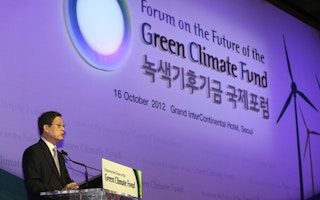The Green Climate Fund, designed as the United Nations’ most important funding body in the battle on climate change in developing nations, launched its headquarters on Wednesday in South Korea, but uncertainty over finances clouded the event.
The launch was largely symbolic, as the Fund, set up by developed nations to channel most of the $100 billion they aim to spend each year by 2020, is not expected to be fully operational until the latter half of next year.
Rich nations, reluctant to stress their already fragile economies, have not paid up as scheduled. Now the Fund has just $40 million at its disposal, a sum promised by South Korea that must also cover administrative expenses.
“The Fund is on track to start its resource mobilization next year with a rapid and substantial initial capitalization, so that we can get the money flowing to the countries in greatest need,” said Jose Maria Sarte Salceda, co-chairman of the fund’s board.
The Fund will help pay for cuts in greenhouse gas emissions and projects in poor nations to protect communities at risk from the effects of climate change, such as rising sea levels, prolonged droughts and damage to food crops.
Rich nations promised in 2010 to provide $10 billion per year in fast-start climate finance over 2011 to 2013, and scale funding up to $100 billion annually by 2020.
But inflows have fallen far short of expected levels, with new finance even dropping by more than two-thirds in 2013 from 2012, Britain’s Overseas Development Institute says.
For example, it said in a recent report, “Funding in response to German flood damage in 2013 was four times higher than funding to help developing countries adapt to climate change since 2003.”
Most of the climate finance that has emerged so far will be distributed by national governments or private funds run by multilateral organizations such as the World Bank.
Germany and Sweden have signaled willingness to contribute, Executive Director Hela Cheikhrouhou told reporters at Wednesday’s opening ceremony, with Sweden intending to pay $45 million into the fund.
“The office opening is both a symbolic and practical demonstration that the Fund is ready for business,” she said in a statement, but added it would become fully operational around the second half of next year.
The fund was set up at UN climate talks in Mexico in 2010 in recognition that climate change has historically been caused mainly by greenhouse gas emissions in developed countries.
At climate talks in Poland last month, developing nations pushed for a detailed plan to scale up funds, and proposed a target of $70 billion in 2016, but failed to win over developed countries.
The finance aspect remains a sticking point in efforts to agree a new global pact on climate change that nearly 200 nations hope to clinch in Paris in December 2015.
Major emerging economies such as India say they do not want to commit to targets for capping carbon dioxide emissions before the developed world has delivered on its promises on climate finance.
“What is wrong with the Global Climate Fund is that there is no money there,” Indian Environment Minister Jayanthi Natarajan told a news conference during last month’s talks in the Polish capital of Warsaw.










